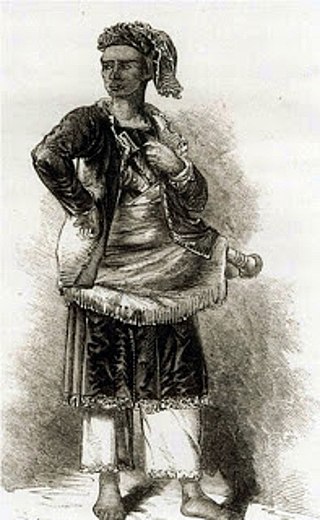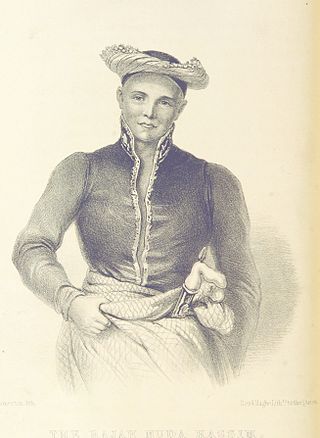The history of Brunei concerns the settlements and societies located on the north coast of the island of Borneo, which has been under the influence of Indianised kingdoms and empires for much of its history. Local scholars assume that the Islamisation of Brunei started in the fifteenth century with the formation of the Bruneian Empire, a thalassocracy that covered the northern part of Borneo and the southern Philippines. At the end of the 17th century, Brunei subsequently entered a period of decline brought on by Brunei Civil War, piracy, and European colonial expansion. Later, there was a brief war with Spain, in which Brunei lost Manila and evacuated their capital for a brief period until the Spanish withdrew. The empire lost much of its territory with the arrival of the Western powers, such as the Spanish in the Philippines and the British in Labuan, Sarawak, and North Borneo. The decline of the Bruneian Empire accelerated in the nineteenth century when Brunei gave much of its territory to the White Rajahs of Sarawak, resulting in its current small landmass and separation into two parts. Sultan Hashim Jalilul Alam Aqamaddin later appealed to the British to stop further annexation in 1888. In the same year, the British signed a "Treaty of Protection" and made Brunei a British protectorate until 1984 when it gained independence and prospered due to the discovery of oil.

Sir James Brooke, Rajah of Sarawak, was a British soldier and adventurer who founded the Raj of Sarawak in Borneo. He ruled as the first White Rajah of Sarawak from 1841 until his death in 1868.

Limbang is a border town and the capital of Limbang District in the Limbang Division of northern Sarawak, East Malaysia, on the island of Borneo. This district area is 3,978.10 square kilometres, and population was 56,900. It is located on the banks of the Limbang River, between the two halves of Brunei.

Omar Ali Saifuddin II was the 23rd Sultan of Brunei. During his reign, Western powers such as the United Kingdom and the United States visited the country. His reign saw the British adventurer James Brooke becoming the White Rajah of Sarawak.

The Ibans or Sea Dayaks are an Austronesian ethnic group indigenous to northwestern Borneo. The Ibans are also known as Sea Dayaks and the title Dayak was given by the British and the Dutch to various ethnic groups in Borneo island.

The White Rajahs were a dynastic monarchy of the British Brooke family, who founded and ruled the Raj of Sarawak, located on the north west coast of the island of Borneo, from 1841 to 1946. The first ruler was Briton James Brooke. As a reward for helping the Sultanate of Brunei fight piracy and insurgency among the indigenous peoples, he was granted the province of Kuching, which was known as Sarawak Asal in 1841 and received independent kingdom status.

The flag of Sarawak, officially known as Ibu Pertiwi, is the official flag of Sarawak, a state in Malaysia. It is based on the flag of the Raj of Sarawak of the White Rajah, and includes the yellow of Southeast Asian royalty — a similar yellow and diagonal black are in the flag of Brunei, although Brunei's yellow is of a brighter shade.

Abdul Momin was the 24th Sultan of Brunei from 1852 until his death in 1885.

Melanau or A-Likou is an ethnic group indigenous to Sarawak, Malaysia. They are among the earliest settlers of Sarawak. They speak in the Melanau language, which is a part of the North Bornean branch of Malayo-Polynesian languages.

Hashim Jalilul Alam Aqamaddin was the 25th Sultan of Brunei from 1885 to 1906.

The Raj of Sarawak, also the Kingdom of Sarawak or State of Sarawak, located in the northwestern part of the island of Borneo, was an independent state founded in 1841, in a treaty of protection with the United Kingdom starting from 1888. It was established from a series of land concessions acquired by an Englishman, James Brooke, from the Sultan of Brunei. Sarawak was recognised as an independent sovereign state by the United States in 1850 and by the United Kingdom in 1864. The Kingdom is now the Malaysian state of Sarawak.
Rentap, also known as Libau Rentap, was a warrior and a recognized Iban hero in Sarawak during the reign of the first White Rajah, James Brooke. His praisename, Rentap Tanah, Runtuh Menua translates from the Iban language as 'Earth-tremor, World-shaker'. His famous and frequently quoted slogan was "Agi idup, Agi ngelaban" which translates into "Still alive, still fighting".
Syarif Masahor bin Syarif Hassan, also written as Sharif Masahor was a famous Malay rebel of Hadhrami descent in Sarikei, Sarawak state, Malaysia during the Brooke White Rajahs era in that state.

The Lun Bawang is an ethnic group found in Central Northern Borneo. They are indigenous to the southwest of Sabah and the northern region of Sarawak, highlands of North Kalimantan and Brunei.

The History of Sarawak can be traced as far as 40,000 years ago to the paleolithic period where the earliest evidence of human settlement is found in the Niah caves. A series of Chinese ceramics dated from the 8th to 13th century AD was uncovered at the archeological site of Santubong. The coastal regions of Sarawak came under the influence of the Bruneian Empire in the 16th century. In 1839, James Brooke, a British explorer, first arrived in Sarawak. Sarawak was later governed by the Brooke family between 1841 and 1946. During World War II, it was occupied by the Japanese for three years. After the war, the last White Rajah, Charles Vyner Brooke, ceded Sarawak to Britain, and in 1946 it became a British Crown Colony. On 22 July 1963, Sarawak was granted self-government by the British. Following this, it became one of the founding members of the Federation of Malaysia, established on 16 September 1963. However, the federation was opposed by Indonesia, and this led to the three-year Indonesia–Malaysia confrontation. From 1960 to 1990, Sarawak experienced a communist insurgency.

The British Military Administration (BMA) was the interim administrator of British Borneo between the end of the Second World War and the establishment of the Crown Colonies of Sarawak and North Borneo in 1946. Specifically, the entity lasted from 12 September 1945 to 1 July 1946. Labuan became the headquarters of BMA. The headquarters was mostly managed by the Australian Imperial Force (AIF). The area under this administration today comprises Labuan, Sabah, Sarawak, and Brunei. Sarawak was administered by Australians under British Borneo Civil Affairs Unit (BBCAU).

The Sultanate of Sarawak was a Malay kingdom, located in present-day Kuching Division, Sarawak. The kingdom was founded in 1599, after the conquest of the preceding Santubong Kingdom and the later Sultanate of Brunei.

Edge of the World is a 2021 adventure drama film directed by Michael Haussman and starring Jonathan Rhys Meyers as the British soldier and adventurer James Brooke (1803–1868), the first White Rajah of Sarawak. The film also features Atiqah Hasiholan, Dominic Monaghan, Hannah New, and Josie Ho. The script was written by Rob Allyn, who also produced the film. Edge of the World is a co-production between Malaysia, China, the US and the UK.

Pengiran Mohammad Salleh (1790s–1858) or commonly referred to by his title Pengiran Indera Mahkota, was a Bruneian nobleman and politician who was governor of Sarawak in 1827. In the region that is now part of Sarawak, he founded the city of Kuching in 1827.
Prince Hashim of Brunei or commonly referred to by his title Pengiran Muda Hashim and Raja Muda Hashim, was a Bruneian prince who was the son of Sultan Muhammad Kanzul Alam, and uncle to Sultan Omar Ali Saifuddin II.
















